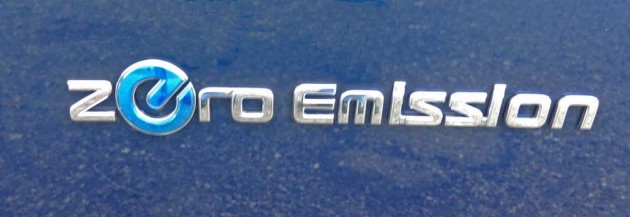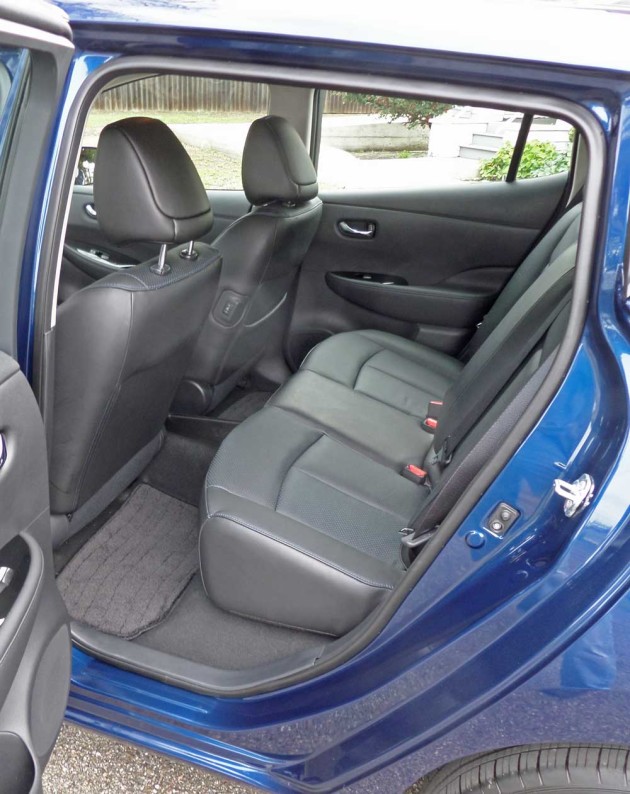?2016 Nissan Leaf SL?
Improved battery increases range by 27 Percent

The Nissan Motor Co., Ltd. launched what they claimed to be the world?s first affordable, zero-emission car in the form of the new 2011 Nissan Leaf – a 4-door, medium-size, lithium-ion battery powered, plug-in electric hatchback, capable of comfortably transporting five adults.

The Leaf is based on Nissan?s ?B? car platform which also supports the Versa, but is 6-inches longer. Nissan has had a long history in both electric vehicle and battery technologies beginning research and development in 1992. In 1995 the Prairie EV was launched, followed by the Altra EV and then the Hyper Mini and several test and concept electric vehicles.

The Leaf is a 100%plug-in electric vehicle with zero emissions. There is no supplemental gasoline engine as in a Hybrid Electric vehicle, so oil changes are no longer necessary. Obvious competitors will be the Ford Focus EV, Mitsubishi i-MiEV, with the Chevy Volt and Toyota Prius Plug-in Hybrids figuring in the picture as well.
The 2016 Nissan Leaf is available in three trim levels: S; SV; and SL ? the latter including leather seating surfaces. A solar panel and rear backup camera are optionally available.

Leaf?s power comes from a 600 pound laminated Lithium-ion Manganese Graphite battery pack mounted low in the vehicle floor for optimum weight distribution, and a high-response synchronous AC electric drive motor (80kW / 197 horsepower and 187 pound feet of torque) with a power capacity of 24kWh / over 90kW in the base S model and 30kWh in SV and SL trims., delivering energy to the front wheels. Top speed for the Leaf is 90 mph and the range capability is 100 miles plus. The battery pack consists of 192 cells, with 4 laminate cells per module in 48 modules. The battery comes with an 8-year, 100,000-mile warranty, and the battery is expected to retain 70-80 percent of its original storage capacity after 10 years.

When battery power is drained to a minimum point, recharging is quite simple via a supplied 120 V portable trickle charge cable that may be plugged into any conventional household outlet. An optional 240V charging is available. There are actually three levels of recharge technology: Level I is a 110V (30kW) trickle type that fully recharges in roughly 26 hours; Level II is the normal recharge method for both home and public usage at 3.3kW (220 V) that requires approximately 6 hours; and the third level ? DC Fast Charge is a quick type for public and private use at 50kW that will deliver an 80 percent charge in 30 minutes. Charging for Level 1 and 2 stations must be hardwired, and the standard for quick charging is still pending, and essentially cost prohibitive for home and public usage. There are currently thousands of public charging stations nationwide. The Leaf?s charging plugs are located in a small forward compartment located just below the hood. The 30 kWh battery pack weighs just 46 pounds more than the 24 kWh battery pack and has the same battery pack size and footprint. The 2016 LEAF SV and SL have MPGe ratings of 124 city, 101 highway and 112 combined fuel economy, while LEAF S has MPGe ratings of 126 city, 101 highway and 114 combined. There is also a standard photovoltaic solar panel spoiler on SL models, which supports charging of the 12-volt battery for vehicle accessories.

The Nissan Leaf has no gas tank, tailpipe, nor does it have a conventional transmission to complicate maintenance. In fact, the only real maintenance requirements are tire rotation and windshield wiper blade replacement. Okay, washing and waxing occasionally will certainly help to maintain a pristine exterior appearance.

There are three operational modes: a Normal Drive mode; an Eco mode, which increases efficiency and delivers more range by reducing power output while increasing regenerative braking; and a B-mode, which aggressively engages regenerative braking during deceleration. Directional selection is accomplished via a center stack-mounted ?Palm shifter? that operates on the principle of a computer mouse or joystick, and there is an eco button located on the steering wheel.

The Nissan Leaf is ideally suited for sustainable mobility in a partnership with the Sumitomo Trading Corp, having created a business around the secondary use of Lithium-ion batteries, employing a 4R business philosophy: Reuse; Refabrication; Recycling; and Resales.
The Leaf?s dedicated EV body was designed to provide what Nissan refers to as ?smart fluidity? ? a fusion of sophisticated aerodynamic management and aerodynamic acoustics with the freedom provided by the EV layout. The smooth, elegant lines of the body begin with the low, compact hood, and moves through the distinctive shoulder character line and on toward the integrated large rear spoiler.

The exterior styling is distinctive and is emphasized by a sharp, upright V-shaped design featuring long, upward-slanting LED headlights with a blue internal reflective appearance. The headlights effectively split and redirect airflow away from the door mirrors, helping to reduce wind noise and drag, and also consume only about 50 percent of the electricity of conventional halogen headlights. At the rear, the slim-type aerodynamic vertical LED taillight design and angular corners blend with the aerodynamic muffler-less rear bumper and rear diffuser managing the aerodynamics of the rear end without sacrificing rear interior space. The drag coefficient measures only 0.28.

The exterior also utilizes a flat underbody (including a large front flat floor cover, motor area undercover, front undercover and rear diffuser with fins) to help manage under vehicle airflow. An innovative vortex-shedding roof-mounted antenna is but one of many design elements incorporated in reducing wind noise. Other noise reduction measures include a quiet-operation windshield wiper
motor, a sound insulation windshield design and a dual-isolated motor-mounting system.

The interior includes navigation as standard fare, push button start, a digital meter cluster, CARWINGS ? a remote charge status monitor and advanced user interface for range management including connectivity through smart phone applications. Information screens are provided for tracking energy flow in both the Nav system and driver info display. Audio, entertainment and connectivity features have been upgraded, starting with the addition of standard NissanConnectSM with Mobile Apps with 5.0-inch color display for LEAF S models. The system includes Bluetooth? Hands-free Phone System, Streaming audio via Bluetooth?, Hands-free Text Messaging Assistant and USB connection port for iPod? interface and other compatible devices.

My 2016 test Nissan Leaf cam in the top-of-the-line SL trim. It wore a Deep Blue Pearl metallic exterior finish, with the interior done in Black. The base price was set at $36,790., while the price as tested came to $39,390 after adding options but before factoring in tax credits and rebates. The options included: floormats and a cargo mat as well as the Premium Package with the Around View? monitor and BISE 7-speaker audio system. Pricing for the Nissan Leaf in S trim begins at $29,010.
SUMMARY: Piloting the Nissan Leaf is really not a dramatically different process from driving a conventionally powered or hybrid powered vehicle, except that it is eerily quiet. One tends to notice road and wind noise more due to the lack of an engine. Drive rationally and conservatively and watch a tree grow graphically in the information panel, or drive in a completely normal manner and simply monitor the potential range balance.

Acceleration is instantaneous in a luxurious silence, and the handling delivers a nimble feel. It rained on arrival day and while some may be concerned about operating an electric vehicle in the wet, there?s really nothing to worry about as the Leaf has undergone severe durability testing, packed in ice to measure internal pressure by rapid cooling and fully submersed as well as exposed to high pressure washing. It has proven to be completely watertight. In addition, the battery pack escaped damage in a 40 mph frontal offset crash test.
Braking features a normal set-up along with ?Coasting? regenerative braking, which contributes to maintaining battery power levels.
I found the Nissan Leaf to be fun, enjoyable and reliable in both normal and Eco modes. The only areas for improvement that I noted in testing the original 2011 Leaf were: for a locking mechanism for the charge cable when recharging; better light management in bright sunlight, which renders the IP illegible; and for a softer edge for the center stack. All of the issues have been satisfactorily addressed in the 2016 Leaf. Bottom line, given all of its advantages, the Leaf makes for a good sense purchase or lease for the average commuter.
[wptabs style=”wpui-light” effect=”slide” mode=”horizontal”]
?[wptabtitle] SPECIFICATIONS: 2016 Nissan Leaf SL [/wptabtitle]
?? [wptabcontent]
| Base Price: | $36,790. |
| Price as Tested: | $39,390. ? minus federal tax credit, and other possible credits. |
| Engine Type and Size: | High Response 80kW AC synchronous electric motor, powered by a laminated lithium-ion battery in a 192 cell module pack – 24 kWh / 30 kWh with 6.6 kW onboard charger. |
| Horsepower (bhp): | 107 |
| Torque (ft./ lbs.): | 187 |
| Transmission: | Single speed reducer with shift-by-wire drive selector. Three modes ? Normal; Eco-mode; and B-mode. |
| Drive Train: | Front mounted engine / Front-wheel drive. |
| Suspension: |
Front – Independent MacPherson strut w/ coil springs and stabilizer bar. Rear – Torsion beam with integrated stabilizer bar. |
| Brakes: | Power-assisted Cooperative regenerative four wheel vented discs with electrically-driven Intelligent Brake, 4-Wheel ABS, BA, EBD and electronic center console, electronic toggle switch activation. Also VDC, TCS and TPMS. |
| Tires: | Michelin Energy Saver 215/50 R17 mounted on 5-spoke sculpted machine-finished aluminum with painted recess alloy wheels. |
| Wheelbase: | 106.3 inches |
| Length Overall: | 175.0 inches |
| Width: | 69.7 inches |
| Height: | 61.0 inches |
| Curb Weight: | 3,391 lbs. |
| Fuel Capacity: | N/A gallons |
| EPA Mileage Estimates: | 84 MPGe (S) / 107 MPGe (SV & SL) |
| Drag Coefficient: | 0.28 |
| 0 – 60 mph: | Not tested |
?? [/wptabcontent]
[/wptabs]
 Arv Voss is a Northern California based freelance motoring Journalist and member and past officer of several noted Automotive Journalist organizations who contributes regularly to a number of national and international media outlets. He reviews not only cars, trucks and SUVs, but motorcycles and unusual wheeled vehicles as well.
Arv Voss is a Northern California based freelance motoring Journalist and member and past officer of several noted Automotive Journalist organizations who contributes regularly to a number of national and international media outlets. He reviews not only cars, trucks and SUVs, but motorcycles and unusual wheeled vehicles as well.








